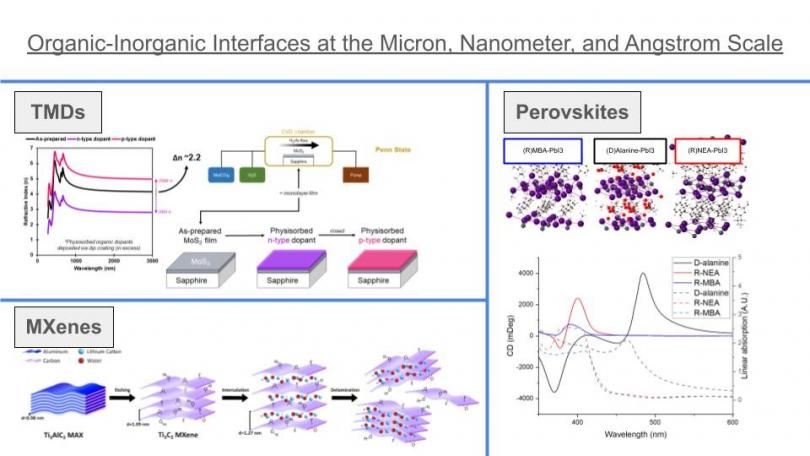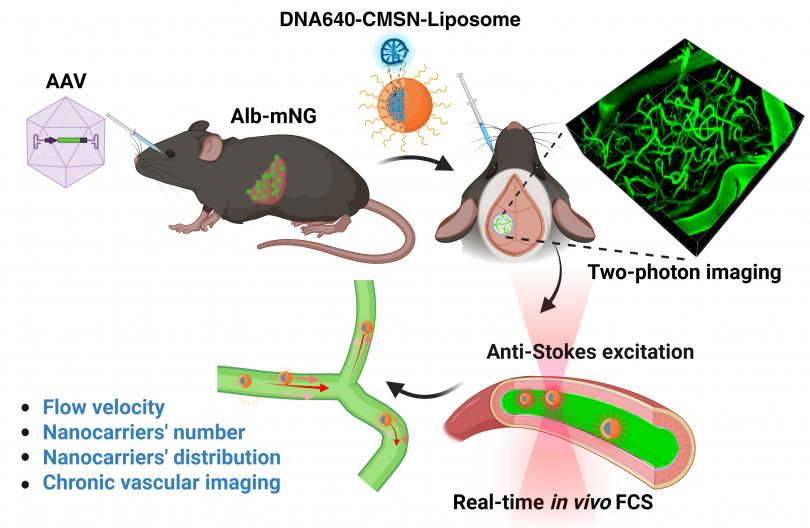Soft PhotoElectroChemical Systems for Energy Conversion and Storage
Abstract: Organic semiconducting polymers present a versatile platform for energy conversion and storage and sensing devices due to tunable optical and transport gaps, compatibility with electrolytes, and scalability via solution processing. The Center for Soft Photoelectrochemical Systems is an Energy Frontier Research Center that focuses on understanding the fundamental factors that control charge and matter transport processes that underpin energy conversion and storage technologies across spatiotemporal scales in scalable, durable, π-conjugated polymer materials. Within SPECS, we aim to establish design rules for robust photocathode systems that elucidate key structure–property relationships related to charge transport, charge transfer and operational durability.
Our initial device employs a bulk heterojunction (BHJ) strategy, combining PTB7-Th (hole transport) and N2200 (electron transport) polymers, deposited on passivated ITO and capped with a hydrogen evolution reaction (HER) catalyst (e.g., Pt or RuO₂), all immersed in an acidic electrolyte. Insights from optoelectronic analogs guide our focus toward enhancing chemical and mechanical interfacial stability and enabling selective charge extraction.
Efforts that will be described in this talk include multiple spectro-electrochemical methods and theoretical efforts to reveal the impact of electrochemical doping and ultimately serve as signatures to drive charge transfer reactions such as solar fuel production. Other highlights will include opportunities to functionalize various interfaces to increase rates of hydrogen evolution.

Bio: Erin L. Ratcliff is a full professor in the School of Materials Science and Engineering and the School of Chemistry and Biochemistry at the Georgia Institute of Technology and holds a joint appointment at the National Renewable Energy Laboratory. She earned a B.A. in chemistry, mathematics,and statistics in 2003 from St. Olaf College in Northfield, Minnesota, and a Ph.D. in physical chemistry from Iowa State University in 2007. After completing a postdoc at the University of Arizona (2007-2009), she served as a research scientist and research professor in the Department of Chemistry and Biochemistry (2009-2014). She was previously an assistant and associate professor in the Department of Materials Science and Engineering and the Department of Chemical and Environmental Engineering at the University of Arizona (2014- 2024). She joined the faculty at Georgia Tech in 2024.
Her group, Laboratory for Interface Science for Printable Electronic Materials, uses a combination of electrochemistry, spectroscopies, microscopies and synchrotron-based techniques to understand fundamental structure-property relationships of next-generation materials for energy conversion and storage and biosensing. Materials of interest include metal halide perovskites, π-conjugated materials, colloidal quantum dots and metal oxides. Current research is focused on mechanisms of electron transfer and transport across interfaces, including semiconductor-electrolyte interfaces and durability of printable electronic materials.
Ratliff was also the director of the funded Energy Frontier Research Center (EFRC) titled Center for Soft PhotoElectroChemical Systems (SPECS) and is currently the associate director of scientific continuity for SPECS. She has received several awards for her research and teaching, including the 2023 Da Vinci Fellow and the 2022 College of Engineering Researcher of the Year award at the University of Arizona, She received the Ten at Ten People of Energy Frontier Research Centers DOE Basic Energy Sciences award in 2019 and a Senior Summer Faculty Research Fellowship at the Naval Research Laboratory (2020, 2021, and 2024). Her research program has been funded by the Department of Energy Basic Energy Sciences, the Solar Energy Technology Office, Office of Naval Research, National Science Foundation and the Nano Bio Materials Consortium.
This lecture series commemorates the life and legacy of Professor Susan Odom, an energetic, productive and driven faculty member in the Department of Chemistry from 2011 to 2021. It features speakers noted for outstanding research in Professor Odom’s fields of synthetic and materials chemistry. Visit this page for more information on the Susan A. Odom lecture series.



 Bio: Jennifer Pore leads an innovative gas phase chemistry program at Lawrence Berkeley National Laboratory, where she investigates the fundamental properties of superheavy elements, examining them one atom at a time. A San Francisco native, she earned her Bachelor of Science at Mills College, a women's college in Oakland, CA. She then moved to Canada to complete her Master’s and Ph.D. in nuclear science before returning to California and joining the Lawrence Berkeley team. Her primary research interest focuses on probing the chemical properties of superheavy elements to explore whether the periodic table should be reorganized. Jennifer has recently received a DOE Early Career Award to further investigate the chemistry of superheavy elements.
Bio: Jennifer Pore leads an innovative gas phase chemistry program at Lawrence Berkeley National Laboratory, where she investigates the fundamental properties of superheavy elements, examining them one atom at a time. A San Francisco native, she earned her Bachelor of Science at Mills College, a women's college in Oakland, CA. She then moved to Canada to complete her Master’s and Ph.D. in nuclear science before returning to California and joining the Lawrence Berkeley team. Her primary research interest focuses on probing the chemical properties of superheavy elements to explore whether the periodic table should be reorganized. Jennifer has recently received a DOE Early Career Award to further investigate the chemistry of superheavy elements.

 Cerebrovasculature refers to the network of blood vessels in the brain, and its coupling with neurons plays a critical role in regulating ion exchange, molecule transport, nutrient and oxygen delivery, and waste removal in the brain. Abnormalities in cerebrovasculature and disruptions of the blood supply are associated with a variety of cerebrovascular and neurodegenerative disorders. Nanocarriers, a nano-sized drug delivery system synthesized from various materials, have been designed to encapsulate therapeutic agents and overcome delivery challenges in crossing the blood-brain barrier (BBB) to achieve targeted and enhanced therapy for these diseases. Unraveling the transport of drugs and nanocarriers in the cerebrovasculature is important for pharmacokinetic and hemodynamic studies but is challenging due to difficulties in detecting these particles within the circulatory system of a live animal. In this dissertation, we developed a technique to achieve real-time
Cerebrovasculature refers to the network of blood vessels in the brain, and its coupling with neurons plays a critical role in regulating ion exchange, molecule transport, nutrient and oxygen delivery, and waste removal in the brain. Abnormalities in cerebrovasculature and disruptions of the blood supply are associated with a variety of cerebrovascular and neurodegenerative disorders. Nanocarriers, a nano-sized drug delivery system synthesized from various materials, have been designed to encapsulate therapeutic agents and overcome delivery challenges in crossing the blood-brain barrier (BBB) to achieve targeted and enhanced therapy for these diseases. Unraveling the transport of drugs and nanocarriers in the cerebrovasculature is important for pharmacokinetic and hemodynamic studies but is challenging due to difficulties in detecting these particles within the circulatory system of a live animal. In this dissertation, we developed a technique to achieve real-time